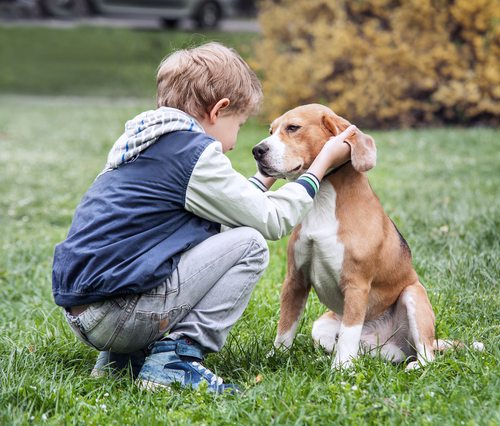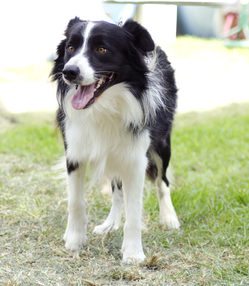Provocation for facial dog bites must be considered as a possible explanation in most dog bite injuries inflicted to the face of the child. This opinion is widely held among most to most animal behavior experts.

For example, many experts believe that children often interact with dogs in a manner that might be provocative. And on occasion, what may not seem provocative to the victim may well, in fact, be something that would provoke the dog to bite. This is particularly true in dogs with a history of biting attacks on people.
Recently I received an email from an owner whose border collie attacked her 13-year-old daughter. She was confused about why the incident happened and sought my expert opinion about the reasons causing the attack.
Background and summary
The victim was a 13-year-old girl who lived with her family, and a male border collie, approximately six years old. The reproductive status of the dog is not known. The border collie was a family dog, and all household members are very familiar with the dog. At the time of the incident the victim was interacting with the dog, as described below, and suddenly without warning the dog turned and bit the victim on the head and face. She required less than 20 stitches. The victim was not hospitalized.
Description of the incident from the owner

“We had our border collie for 5 years he had shown up at my place of employment. I was unable to locate the owner. The dog had never shown any aggressive behavior except for other dogs. He was always an inside dog with us a very smart, well behaved mannerly dog. We loved him very much. He was part of our family.
In October, he bit my 4-year-old nephew in the face. The dog was laying on my lap and lashed out at my nephew when he reached to pet him. Very thankful, my sister and I were right there. We picked up my nephew and threw him out of dog’s reach.
I excused my dog’s behavior due to a small child he did not know that well. Then in December, he was lying on my 13-year-old daughter’s lap being petted on the couch. She was on one end and I on the other. The dog was between us. His head was laying on her lap. We were just talking quietly. Out of nowhere jumped up and started attacking her in the face. He would not stop with my commands. I hit the dog with something lying on the table. It caused him to stop. She had to get 22 stitches to her eye and ear.
I had him put down after this due to his new sudden aggression. I was sitting right there. Nothing provoked him. No warning of any kind. He was resting on her lap by his choice.
I had animal control come to pick him up for me. It killed me, still, miss him terribly, and my daughter still misses him. He was one of her most favorite people. We will always wonder what caused this or triggered this behavior.”
Was provocation a cause for this dog bite incident?
This adult, male collie most likely had existing propensities for human-directed aggression prior to the incident in question. Functionally, some animal behaviorists would categorize the type of attack that happened here as being that of “dominance.” Dominance as a concept used to explain canine behavior has been criticized, and its limitations in explaining dog-human social interaction are warranted.
However, a functional description using dominance as a means to understand human-directed aggression may be helpful in the sense that it differentiates the causes from other types of canine aggression, at least on a functional basis. That is, descriptively, dominance-based human aggression differs from human-directed aggression due to maternal, protective, fear-based, possessive or inter-male reasons.
I believe it is highly significant that your daughter was petting your border collie for some time before he suddenly jumped up and started attacking her in the face. Her petting continued until it reached the point where this socially benign jester probably exceeded the threshold with which this type of “dominant” dog would tolerate from your daughter. Hence, the nature the social relationship between your daughter in the dog before the incident must be understood in detail.
It probably would be faulty to say that past interactions were characterized by non-aggressive dominant behavior from the dog towards your daughter. More accurately, your daughter simply and consistently may have acted submissively to the dog. I don’t know exactly what submissive interactions regularly took place but often what is found is that submissive family members yield space to the dog, allow the dog to rest or place their head on a persons lap (as in the current instance) or generally are unable to control the dog in different contexts.
So, in short, I believe the petting actions were provocative from the dog’s perspective, but not necessarily from the perspective of your daughter. You also must realize that provocation as an issue in dog bite cases is not a straightforward issue. Many variables must be assessed to conclude that any given act directed to a dog was provocative.
One criterion here was the change in motivation. Your dog was resting before leaping and biting your daughter’s face. Another criterion is the nature of the response directed to the dog. The dog’s reaction was elicited through your daughter petting to the dog’s head. And next, the aggressive response from the dog was immediate. Change in motivation, the direction of the victim’s response, and the immediacy of a dog’s response are criteria that may be used in selected instances to define provocation, at least from the dog’s perspective.
However, a concern in using these criteria has to do with the temperament of the dog. This border collie was already “primed” for human-directed aggression, and its inclinations to do so were recognizable given the previous attack on your four-year-old nephew.
Hence, the question becomes, how can you provoke a dog into aggression who already has propensities for aggression. If, for example, this dog had no history of attack, then I would label your child’s behavior as provocative, but this was not the case in the current instance. Hence, the best explanation must be tied to the temperament of the dog not being able to tolerate certain kinds of social interaction. Whether this particular border collie, regarded by many experts as one of the most intelligent breeds of dog, is best described as a “dominant dog” is controversial. This issue has been addressed in the book of John Bradshaw and other peer-reviewed scientific publications in animal and veterinary behavioral medicine. And other posts about provocation in dog bite cases can be found elsewhere on this website.
